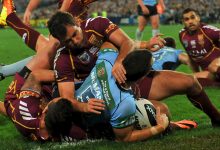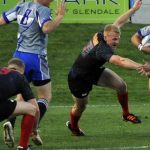State of Origin Star Sues NRL Over Head Injuries

Former NSW State of Origin winger James McManus is taking legal action against the Newcastle Knights over the club’s handling of his concussions, in a landmark case that could have significant ramifications for Australian sport.
McManus played 166 NRL games for the Knights before retiring on medical grounds at the end of the 2015 season. The claim for negligence, which is listed for a directions hearing in the Supreme Court later this month, could set a precedent for other players who are seeking damages for injuries and result in additional protections being implemented to protect against serious head injury.
Abroad
In the United States, the National Football League (NFL) is set to pay out nearly $1 billion to retired players after an historic settlement for injuries sustained during play.
More than 4500 retired NFL players commenced a class action against the league for covering up the long-term health risks of football-related head trauma.
The rise of professional sport
The current generation of NRL players is the first to dedicate their working lives to the sport.
Previously, most players had ‘day jobs’ which brought in the bulk of their remuneration. The rise in salaries has contributed to increased training intensity, bigger and stronger players, and a greater risk of injury.
Similarly in Rugby Union, the average weight of the England team in 1994, a year before the advent of professionalism, was 92.3kg. The current English team averages 105.1kg, creating added impact to the players’ bodies.
The England Rugby Players’ Association reports that retirements through injury have risen by 80 per cent over the past three years. Concussions have become the most common match-day injury, increasing from 3.1 per 1,000 playing hours in 2005-06 to 6.7 per 1,000 hours in 2012-13.
Concussion-related injury
Repeated or severe blows to the head are associated with chronic traumatic encephalopathy (CTE).
The condition has been linked to aggression, confusion and depression among those who have suffered repeated head trauma.
After years of disputing evidence that its players were more likely to suffer brain damage than the general population, the NFL revealed in court documents that it expects up to one in three former players to develop dementia, Alzheimer’s disease, or other neurological disorders like Parkinson’s Disease.
The McManus case
After sustaining several concussions, McManus was diagnosed with “minor brain damage” and “scarring on the brain” which led to a number of health problems, including headaches and mood swings. Doctors recommended that he abstain from exercise for 6 months, but he decided to continue playing.
The head of the Rugby League’s Players’ Union, Ian Prendergast, remarked that this type of legal action is inevitable with the growing body of scientific knowledge on concussions. “We’re supportive of [McManus] going down this path, and in that respect of any player who does,” Prendergast said.
Newcastle Knights chairman Brian McGuigan foreshadowed that the club would be defending the claims made against it. “Players have got to be approved to go back on the ground by the doctors, the medical staff,” McGuigan said.
“If he is deemed to be fit, all we do is abide by that, all we have ever done is abide by that,” he added. “We have never put anyone under pressure to go back on the field were they not approved by the medical staff as being ready to go back on the field.”
Negligence
As McManus’ employer, the Newcastle Knights owes a duty of care to him and other players.
To prove negligence, McManus will need to establish that concussion-related injury was reasonably foreseeable to the NRL but the organisation failed to take reasonable steps to reduce the risk.
In the United States case of NFL v Maxwell, the court listed the types of failures that could amount to negligence in the context of football-related injury claims. These were:
- Failure to regulate or monitor practices, games and medical care so as to minimise long-term risks
- Failure to require that an adequate concussion brain injury history be taken of players.
- Failure to invoke league wide guidelines policies and procedures regarding the identification and treatment of concussive brain injury and return-to-play procedures
- Failure to properly inform players of the health risks associated with concussive injury
Closer to home, the NSW Civil Liability Act contains certain exemptions from liability for injury – including section 5L which says there is no liability for harm suffered from obvious risks of dangerous recreational activities. Section 5K of the Act defines “dangerous recreational activities” to include “any sport (whether or not the sport is an organised activity)”.
However, as Gleeson CJ noted in Agar v Hyde; Agar v Worsley [2000] HCA 41:
“Voluntary participation in a sporting activity does not imply an assumption of any risk which might be associated with the activity, so as to negate the existence of a duty of care in any person in any way involved in or connected with the activity.”
It will be interesting to see how the competing arguments of the parties are ventilated and determined in court.






